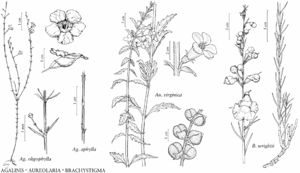Brachystigma wrightii
Proc. Acad. Nat. Sci. Philadelphia 80: 433. 1928.
Perennials unbranched or branching at caudex. Stems slender, 30–55 cm. Leaves: blade filiform-linear, 30–60 x 2–3 mm, proximals longer than distals. Inflorescences racemes of paired flowers, occupying to 2/3 height of stem, bracts resembling foliage leaves. Pedicels 11–30 mm. Flowers 10–26 x 7–16 mm; calyx 3–5 x 4–7 mm, lobes broadly deltate, 1–1.5 mm; corolla abruptly inflating just beyond calyx, 24–30 mm diam., externally pubescent, internally glabrous, lobes orbiculate; filaments 8–11 mm, anthers included, base bluntly sagittate, glabrous, locules equal, 5 mm; ovary ovoid, 4–5 x 2–4 mm; style incurving at maturity, 5–6 mm. Capsules with persistent calyces, globular-ovoid, 8–10 x 5–8 mm. Seeds reticulate, 2 mm.
Phenology: Flowering Aug–Oct; fruiting Oct–Dec.
Habitat: Dry mountain slopes, often in oak chaparral.
Elevation: 1200–2000 m.
Distribution
Ariz., N.Mex., Mexico (Chihuahua, Sonora).
Discussion
Selected References
None.
